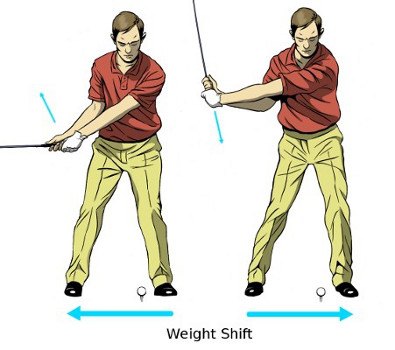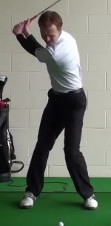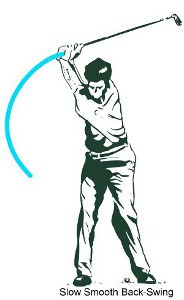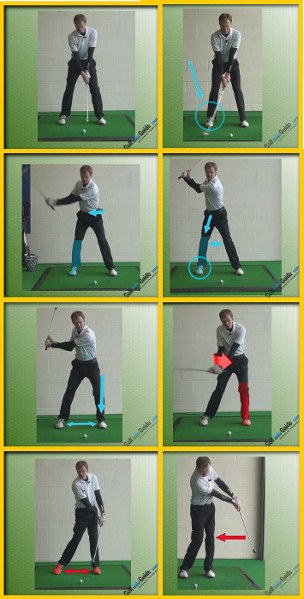
What’s the greatest feat a pro golfer accomplishes on a daily basis? Making a difficult game look easy.
When swinging a driver, the average PGA Tour player generates clubhead speed in excess of 115mph. And they rarely swing at more than 90-percent power. The average golfer is closer to 90mph – and exerts far more energy to produce far less speed.
Pros are blessed with more natural ability than most of us, of course, but their efficiency involves more than raw talent or perfect technique. When watching the next televised tournament, pay attention to the timing and fluidity with which the players swing. Then commit yourself to emulating their tempo.
It’s easier than you think.
Why It’s Important
While it’s often confused with swing speed, tempo is actually synonymous with rhythm, or the pace at which a golfer swings going back and through.  While some swing with a slow tempo and others more quickly, what’s important is that the backswing and downswing tempos match up.
While some swing with a slow tempo and others more quickly, what’s important is that the backswing and downswing tempos match up.
Too many amateurs take the club back quickly only to decelerate on the downswing, or vice versa. This leads to a loss of clubhead speed, poor balance and an off-track club path. In short -- weak, poorly struck shots.
Swing with an even tempo and you’ll be better able to synchronize the movements of your upper and lower body. You’ll also maintain better balance, and hit the ball much more solidly on a consistent basis.
Who You Should Watch
While quick-tempo pros like Nick Price, Lanny Wadkins and Rickie Fowler have enjoyed lots of success, most golfers are better served taking cues from smooth swingers.  Fred Couples, Ernie Els (aka the “Big Easy”) and Rory McIlroy are most often cited as having enviably silky moves.
Fred Couples, Ernie Els (aka the “Big Easy”) and Rory McIlroy are most often cited as having enviably silky moves.
When watching Couples, Els or McIroy, note that their entire approach mirrors their syrupy swings. They walk with a measured pace, and their pre-shot routines are never rushed. And their tempo remains deliberate under pressure.
Another thing Couples, Els and McIroy share – they’re all extremely long. And only the thickly built, 6’4” Els is considered a big man.
Tempo is equally important when putting. You can’t go wrong copying David Toms, Steve Stricker or Phil Mickelson on the greens.
Apply It to Your Game
The classic tempo tip is to swing every club -- including the driver -- with the same pace as your wedges. After all, when’s the last time you made a full-throttle swing from 100 yards out?
Try this practice drill to get a feel for proper tempo, and use it often to maintain great rhythm, balance and timing. It works especially well to begin a practice session or as a pre-round warmup:
It works especially well to begin a practice session or as a pre-round warmup:
- Place four balls in a line 5-6 inches apart and perpendicular to the target line.
- Using a short or middle iron, hit the first ball at 25-percent power with your full-length swing.
- Move to the second ball and hit it at 50 percent.
- Hit the third ball at 75 percent.
- Hit the fourth ball at 90 percent.
Note: The drill works with any club in the bag.

Play Better Golf by Watching the Pros Tempo
There is a lot that can be learned by watching the best golfers in the world do what they do best. In addition to providing entertainment, spending some time watching golf is a great way to improve your own game. Even if you aren't specifically thinking about how to play better, your game is bound to improve through watching pro golf thanks to the subtle tips and cues you will pick up along the way. Watching and learning from experienced professionals is a common method for improving in any field, and it is no different in golf.
When you tune in to a pro golf event, you will find there is no lack of things to watch for in the games of the top players. You can watch the mechanics of their swings, you can watch their short game magic, and you can even watch how they make good decisions by observing the clubs they select and the targets they pick. Even if you can't make the great swings that most pros are able to execute, you can still take something away from watching golf that will help you shave strokes from your score.
In this article, we are going to review the importance of tempo and how yours can improve from observing the top players on the planet. Tempo is an incredibly important part of your game, yet most players mostly ignore this fundamental. The positions of the golf club throughout the swing get most of the instruction attention, so the average golfer usually spends his or her time on the range working on specific mechanics. While mechanics can help you improve, they aren't going to get you all the way to a consistent game. For that, you will need to add in a smooth and reliable tempo to the mix.
It is hard to find a pro golfer with a poor tempo, because it is nearly impossible to make it to the top levels of the game without great rhythm in your swing. Most of the players who lack tempo are weeded out of the pro game at the lower levels, meaning that just about every single player you can watch on the PGA Tour uses a lovely tempo to send the ball toward the target. That isn't to say that all of their tempos are the same - some prefer to swing slowly, while others are quick from start to finish. However, no matter what kind of tempo a player happens to use, it will be even and consistent throughout the day.
Anytime you watch the pro game with an intention to improve your own performance, it is important to remember that you shouldn't be trying to directly copy the swing of any one player. Each golf swing in the world is unique, and you should be making a swing that comes naturally to you. Trying to replicate the swing of a top player down to the last detail is going to be a failing strategy, so that isn't a road that you should even begin to go down. Instead, take small bits and pieces from various players that you can integrate into your own swing to create an overall game that is uniquely your own.

Why is Tempo So Important?
One of the reasons why many golfers ignore tempo during their practice sessions is due to the fact that they just don't understand what it is that makes this an important part of the game. If you have a clear picture in your mind of why tempo matters and what it can do to help you play your best, you will have no problem choosing to invest time and effort in this key ingredient of the swing. It's no accident that nearly every professional golfer has great tempo - it is vital to solid performance on the course.
Following are three of the biggest benefits to using a smooth and steady tempo in your swing.
- Consistency. Every golfer is searching for consistency, as hitting consistent shots is the real challenge in golf. It actually isn't that hard for most golfers to produce at least one or two good shots - it is the challenge of producing those shots all day long where most players fall flat. Think about your best shots - are they good enough to post a good score, if you hit them all the time? Of course they are. You don't really need to hit better shots - you just need to hit your best shots more frequently. To that end, improving your tempo is one of the most important ways in which you can become a better ball striker from the first hole to the last.
- Clean strike. Hitting the ball cleanly is crucial to playing good golf, and tempo can help you make great impact on a regular basis. Even if you have nice fundamentals in your swing in terms of the positions you reach, you can still struggle to make good contact if you have poor tempo. Your body needs to be in the same place at the same time during each swing in order to create a clean hit, and that simply won't happen if your tempo is a mess. Improving your tempo will allow everything to arrive at impact at the same time, leading to a solid hit on the ball.
- Hold up under pressure. This is perhaps the most important point of all when it comes to tempo. Golf is a game that is all about pressure, whether you are playing on TV in front of millions or you are playing a solo round on your favorite local course. All golfers feel pressure, especially when they have a good round going or when they are playing in a competition. If you would like to perform your best when the stakes are the highest, you will need to look to tempo to steady your swing. It is hard to execute the mechanics of your swing cleanly when the pressure is on, but tempo can help to carry you through. By staying within your tempo even when the nerves have set in, you will be well on your way to coming up with great shots when it matters most.
As you probably would suspect, tempo can help you in more ways than just the three listed above. However, those are a good start, and they should give you plenty of motivation to work on this part of your game. After all, don't you think you would post better scores if you were more consistent, could create a clean strike, and played well under pressure? You certainly would. It may take a bit of time and practice to improve your tempo, but the pay off in the end can be huge.

Elements of Good Tempo
Since every player uses a tempo that is uniquely their own, it can be hard to settle on exactly what it is that makes a tempo 'good'. After all, if there are a bunch of different ways to do it, how are you supposed to know which one is right? Well, it doesn't really come down to a matter of right or wrong. Instead, it comes down to having the right elements present in your tempo, while still allowing for personal style.
As you watch pro golf on TV (or in person), you will notice that there are some elements that are consistent from player to player - even if their overall tempos look nothing alike. Once you understand what parts of the tempo are specifically important, you can get down to work on making sure those features are in place within your own swing. The following list contains three pieces of the tempo puzzle that you should be striving to achieve.
- Even from start to finish. The most important part of your tempo is keeping it even from the start of your swing all the way through to the finish position. You don't want to be changing speeds within your swing, suddenly slowing down or speeding up awkwardly. One of the reasons why the pro golfers make such beautiful swings is that they are able to keep their bodies moving smoothly throughout the swing. Amateur golf swings tend to be somewhat awkward and uneven, but the story is exactly the opposite when viewing professional players. An even tempo will help you to be more consistent, and it will actually help you generate more swing speed at well. No matter what speed you like to use for your tempo, make sure it remains as consistent as possible within your swinging motion.
- True to the player. This is an important point, and it goes back to the point that was made earlier regarding not trying to copy the swing of any one professional. You need to use a tempo that is true to you and your personality, rather than one that has been observed and copied into your own game. For example, if you are a person who talks fast and walks fast, a quick tempo is probably going to come more natural to you. On the other hand, if you are laid back and relaxed, a slow and smooth tempo should get the job done. The best tempos are the ones that match up nicely with the golfer's personality. Think about how you approach life in general and then construct a tempo that matches up with your overall attitude and personality.
- Don't change. Many players tend to get out of their tempo depending on the shot at hand. For instance, if you are trying to hit a particularly long drive, you might be tempted to speed up your overall tempo in order to hit the ball farther. You need to resist this temptation. At the same time, you need to resist the temptation to slow your tempo down if you get in a tight spot and want to be sure that you hit an accurate shot. The best way to play the game is to keep the same tempo from the start of the round right on through to the end. Once you have built a tempo that you trust and believe in, ride it out all the way and use things like trajectory and club selection to adjust the distance of your shots appropriately.
Plenty of golfers tinker with their swings over time, and that's fine. Making subtle adjustments to your physical technique in order to seek better results is just part of the game, and it is one of the ways in which you can improve. However, that tinkering should not extend to your tempo. It is important that you stick with your tempo for as long as you are a golfer in order to develop complete trust in the rhythm of your swing. You should remain focused on working at it on the range to become as consistent as you can be, but making dramatic, intentional changes to your tempo is generally a bad idea.

Watch the Big Picture
If you want to learn from watching professional golfers play the game, don't just watch the actual swings they make. Instead, you should be watching everything, from the way they prepare for the shot to the way they respond once the ball has left the club. Hitting good shots is a process that includes far more than just a swing. While the swing is the most important single element within the process, you need to have a good system for hitting shots that starts from the time you arrive at the ball.
Of course, when watching on TV, you don't always get to see the big picture of how each player goes about hitting a shot. Most tournaments on TV will cut from one shot to the next as quickly as possible - which is great for entertainment purposes, but it doesn't really let you get a great look at how the players are doing their work. For this reason, it is a great idea to attend a tournament in person if you get the chance. Specifically, attending a tournament during one of the early rounds (or a practice round) will give you a chance to get a great look at how the game is actually played at the highest level.
What you will likely notice about these top players is that they are incredibly consistent. They go through the same procedure prior to hitting every shot, and that process doesn't deviate even when they hit a few poor shots along the way. By sticking with the process and trusting in their ability to get the job done, the best pro golfers are able to rise to the occasion when the pressure is on.
So what does this have to do with tempo? Everything. Tempo is about consistency and repeatability, and the process that is used to hit a shot is essential in ensuring that a good tempo is included in your swing. If you rush to hit one shot, and then take your time on the next, it will be extremely difficult (if not impossible) to find a steady tempo. You don’t want to be fighting your tempo simply due to an inconsistent pre-shot routine. Install a reliable process in your game when it comes to shot preparation and your tempo should instantly improve.
If you are ever going to see a player get out of his or her usual routine, it is toward the end of a tournament when the pressure becomes intense. This is why you will regularly see players 'choke' on the top golf tours around the world. As the process breaks down and the routine goes out the window, tempo is damaged and it becomes difficult to hit good shots. Even the best golfers in the world make the mistake of taking too long to decide on a target when the pressure is on, and that indecision can throw off the entirety of the process - which will lead to bad tempo and a poor result. Next time you see a player struggling with pressure near the end of a round, pay attention to their routine as there is a good chance that it has deserted them at the worst possible time.

Don't Fall in Love with Slow Motion
One of the popular habits of avid golfers is to watch the swings of some of the best players in the world in slow-motion. Thanks to the digital age that we are currently living in, it is quick and easy to access video recordings of many of the best golf swings on the planet. When watching these videos, golfers take note of each and every little detail within the positions of the swing, and then they head out to the range with the idea of copying these techniques for themselves.
To be sure, there is plenty that can be learned from watching a professional golf swing in slow motion. Many pros have swings which are technically flawless, so learning from their lead in many ways is a great idea. However, it is important that you don't get too caught up in the idea of watching slow motion swings. When watching in slow-mo, you can't see the tempo of the swing, which is a huge part of the equation. If all you do is watch swings that have been digitally slowed in order for you to get a good look at the mechanics, you will lose out on the chance to learn from the tempo that is being employed.
Another problem with slow-motion video is the risk of losing the connection between the mechanics and the tempo of the swing. Some mechanics are going to work best with a fast tempo, while others will function properly only with a smooth and slow tempo. It is important to maintain this distinction in your head, otherwise you may try to mix the two and the results will be disappointing. The golf isn't simple, and it can't be boiled down to just a series of static positions. It needs to be thought of as a dynamic motion, because that is exactly what it is. Maintain your understanding of the movement of the body and the timing of the rotation along with specific swing positions if you would like to improve.
So should you delete all of your links to slow-motion videos of the best golf swings in the world? No, that isn't necessary. You can still use slow-motion as a way to learn about the fundamentals of the swing, but you should mix that method with viewing regular full-speed recordings as well. By going back and forth between the two, you should be able to learn from both the mechanics of the swing and the tempo that is used to deploy those mechanics. The ultimate goal is simple, and yet extremely difficult to achieve - to stitch together great technique with beautiful tempo in your own swing. That is a tall order, but it would be highly rewarding if you ever found yourself at that point.
There are plenty of reasons to watch professional golf. As a fan of the sport, you can certainly enjoy watching for the simple entertainment value, the pressure of trying to perform on the big stage, and to marvel at the incredible shots that the best players in the world are able to produce. On the other hand, you can also watch golf as a means of improving your own performance. Pay close attention when watching tournaments and even consider keeping a notepad close at hand to jot down any ideas that come into your head along the way. You can still enjoy the entertainment of the event while at the same time bettering yourself for the next time you hit the links. By watching the beautiful swings that are produced on the PGA Tour - and by specifically watching the tempos within those swings - you can make yourself a better player in the near future.






